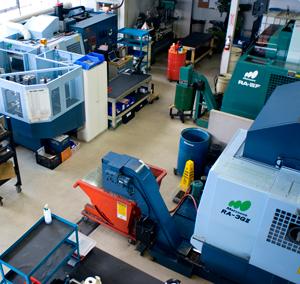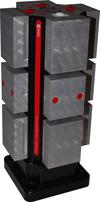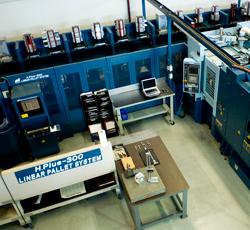- FMA
- The Fabricator
- FABTECH
- Canadian Metalworking
Overnight Success
B.C. company turns to lights-out manufacturing techniques
- October 1, 2010
- Article
- Metalworking

Redline Pro Manufacturing's machining centers can process more than 200 different parts, some with cycle times as short as 8 minutes, during an unmanned overnight shift.
Redline Pro Manufacturing, Surrey, B.C., has been turning out high-precision components for more than 10 years and has kept running smoothly despite a rocky economy.
Founded in 1998 by Traci Bennett, Paul Mowat, and Lyle Hystad, the company started with one machine and 450 sq. ft. of space. They began to carve out a niche as a reliable supplier for the high-tech sector, and today they’re handling jobs from prototype to high-volume on seven machines in 7,000 sq. ft.
The company is also cutting parts nearly 24 hours a day. Redline offers customers just-in-time (JIT) delivery, using a cell system and kanban material management.
“Our customers in the high-tech sector work in a fast-paced, highly competitive market,” said Hystad, a machinist with 25 years of experience. “We can’t anticipate their spec changes, but we can stay nimble to help them adapt quickly and cost-effectively.”
Lights-out Manufacturing
As a rule, the company maintains a single-order stock of finished parts for each customer. When an order is placed, it’s filled immediately. Stock is replenished overnight because, unlike most shops of their size, Redline made the decision to run lights-out.
“We did a lot of research, worked with the OEMs, and talked to software and hardware engineers to learn about advanced machine features, work out the processes, and develop the programs,” said Hystad. “Then we hung out for a few nights as observers. It took a bit of trial and error, but it was well worth it.”
While the addition of a new machining center is always a significant investment, it is even more so in this economy.
Redline can run more than 200 different parts, with cycle times as short as 8 minutes, during an unmanned night shift.
“Our machining centers are programmed to pull out used tools based on calculated wear, which helps prevent an unexpected break,” said Hystad. “If a tool does break, whether someone is here or not, the machine keeps cutting. The machine is programmed to resequence itself, bring up the next tool, and flag the face on that particular pallet as no good and carry on.”
Most days the team turns off the lights at 3:30 p.m. and goes home.

Holding parts rigidly and accurately in the machining envelope is important to the overall success of a machining operation.
“To walk out that door, you have to have confidence in every component of your shop,” said Hystad. “People put a lot of thought into the machine they choose, but sometimes other elements, such as fixturing, are more of an afterthought.”
Hystad explained that he did his homework there, too, and encouraged others to do the same.
“There are a lot of workholding solutions out there. The majority of our projects run on System 5 Multi-Loks from Chick. The speed and repeatability of their QwikChange™ jaw system made them a no-brainer for our cell system,” explained Hystad.
Setups might sit unused for months and then need to be pulled to run a JIT batch. When that happens, the company’s machinists don’t have to adjust the jaws or worry about inconsistency. Instead, they put their time and energy into the parts being made, not the setup.
“We have the confidence that we can take a set of previously machined soft jaws that have been sitting on the shelf for a while, click them onto the pallet, load the raw material, assign the program, and walk away and have the parts come off perfect in the morning,” said Hystad.
Machining Troubleshooting
Hystad’s love of new technology recently led Redline to correct a manufacturing problem that had been plaguing the shop.
“We had a particularly troublesome tool-arbor combination that was creating chatter,” explained Hystad. “The customer didn’t have a major issue with it, but we knew we could deliver better. We also knew that fixing the problem would reduce unnecessary wear and tear on the machine and tooling and allow us to eliminate an extra finishing pass.”
Hystad learned about SHOP-PRO®, a new integrated machine tool testing and chatter vibration analysis product from Manufacturing Automation Laboratories (MAL) Inc.
“We’d run that tool everywhere from 5,000 to 15,000 RPM and hadn’t found the sweet spot,” said Hystad. “MAL set up an accelerometer on the part and attached it via USB to a laptop to chart vibration frequency. On the very first set of taps, they recommended we run at 17,000 RPM, and that did the trick. We got rid of the chatter, increased the feed rate, and eliminated the finishing pass. Within minutes of trying this new technology, we’d discovered a way to cut cycle time in half.”
Not every shop problem can be solved by new machining technologies, but in some cases they can.

With an accelerometer on the part attached to a laptop to chart vibration frequency, chatter can be eliminated and cycle time reduced.
“Machinists by nature and by training seek consistency,” said Hystad. “Our focus is on making sure we’re cutting parts as often as possible and moving seamlessly from one job to the next. In that context, new technology or program changes are a risk. And, in a low-margin business, nobody wants to take a risk with a $500,000 piece of machinery.”
The key to producing lights-out, managing tools, upgrading fixturing, or making any significant process improvement is to understand the risk and then mitigate it.
For more information, visit www.redline-pro.com.
subscribe now


Keep up to date with the latest news, events, and technology for all things metal from our pair of monthly magazines written specifically for Canadian manufacturers!
Start Your Free Subscription- Trending Articles
- Industry Events
MME Winnipeg
- April 30, 2024
- Winnipeg, ON Canada
CTMA Economic Uncertainty: Helping You Navigate Windsor Seminar
- April 30, 2024
- Windsor, ON Canada
CTMA Economic Uncertainty: Helping You Navigate Kitchener Seminar
- May 2, 2024
- Kitchener, ON Canada
Automate 2024
- May 6 - 9, 2024
- Chicago, IL
ANCA Open House
- May 7 - 8, 2024
- Wixom, MI














